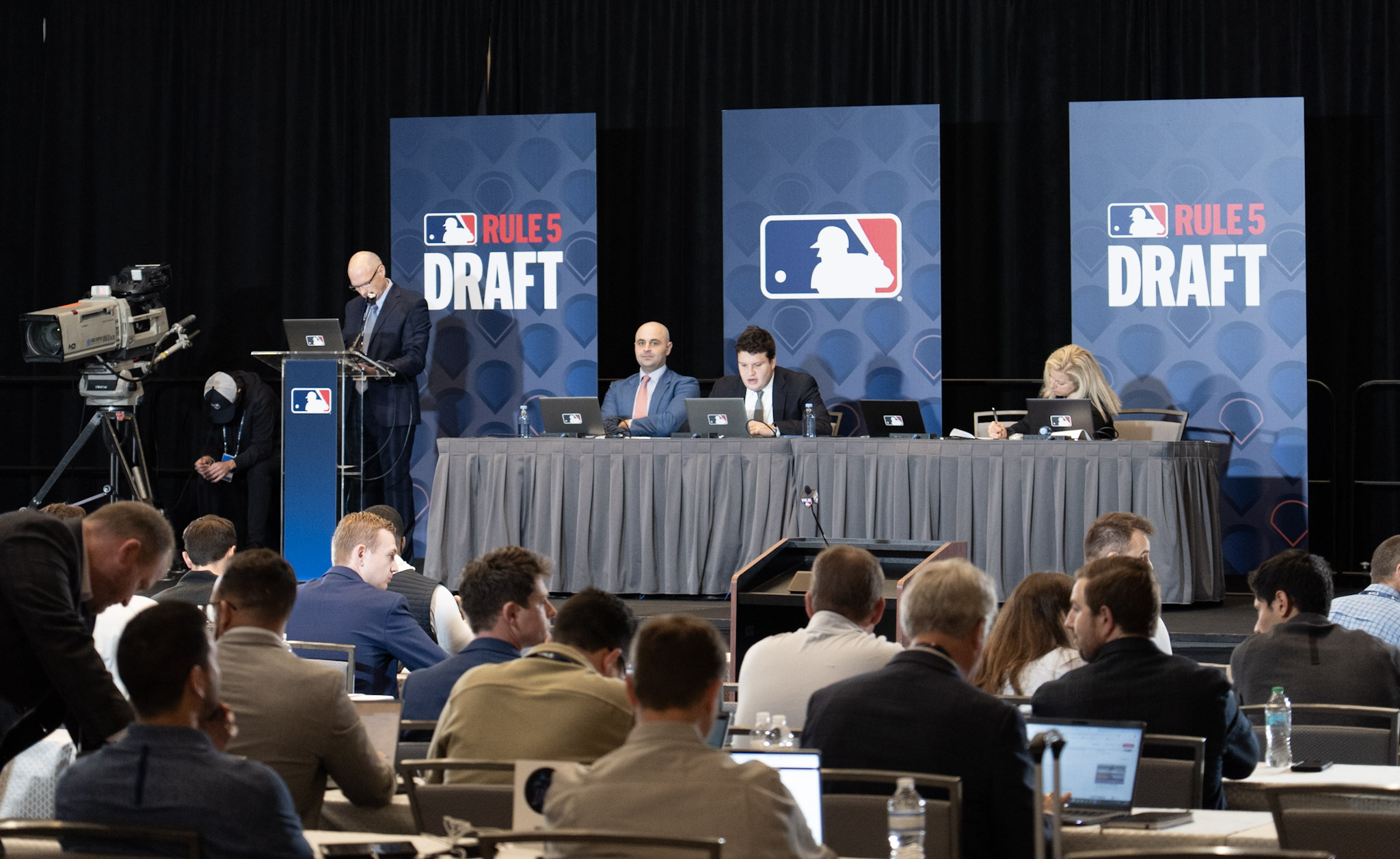WEST SACRAMENTO, Calif. -- As a fellow Bledsoe Agency client training at their facility near Nashville, A's All-Star Brent Rooker had an early look at the tools that made Colson Montgomery a well-regarded hitting prospect.
"The size and athleticism is what stands out," Rooker said, recalling his first impression. "He's a really big kid. He moves well. Strong, loose, whippy, quick twitch. He's got all the physical things you're looking for in a prospect."
But as Montgomery has bulked up and struggled with making contact like never before (42.7 percent strikeout rate this year), his work centered on adjusting to a bigger and stiffer reality with his swing. At the outset of the year, Montgomery discussed reducing his negative move, which is essentially how much his body moves away from the pitcher as he loads up force in his swing. The prevailing logic is that as he's grown bigger and slower, he has less time for extraneous movement and ideally, less need for it.
"A lot of what I was doing was having a really negative initial move," Montgomery said. "I was moving too much, my head was yanking all over the place, which was causing me to chase quite a bit. We sat down with the Sox guys and everyone in August and honed in on what we needed to fix and once we found out what it was, we talked with my hitting guys and some of the White Sox hitting guys. We figured it out and then went balls to the wall with it, and it ended up working out."
As Montgomery now works to swim out from the wreckage of his opening month (.159/.229/.273 entering Sunday), kicked off by an early stretch of uncharacteristic chases of breaking pitches below the zone, it sounds like he could be accused of overdoing it. Both the man himself and others have cited Montgomery's excessive focus on pulling the ball as the undoing of the power and patience combination that should drive his offensive profile, and hitting director Ryan Fuller suggested shaving off too much of his negative move is part of the issue.
"Obviously we don't want to sway back toward the catcher, but we certainly want to have a move where we get connected, where we can read and then make our move forward," Fuller said. "If we have an intent to do something, our body is going to accomplish that move to get off. When he doesn't have that gather move, when it's a little too quick forward, then it's one direction really going to that pull side gap. When he's able to stay connected, make a controlled move forward, he's able to go gap-to-gap"
There's likely been enough changes in Montgomery's body that anticipating more of a low average power-hitter who props up his on-base rate with walks is a safer route to success. But Fuller feels Montgomery's raw power is immense enough that there's no reason he should limit his impact to right field.
"Really working on connecting his body and then when he gets to a strong base, being able to keep his direction through the big part of the field, so we saw [him get] a little spinny at times where he couldn't keep his direction through both gaps," Fuller said. "His gift is he has the ability to go opposite field for a home run just as he can pull side, too. He has really good damage zones up, out, over, so that lends itself to being able to stay through both gaps and hit it hard. When he's going well, it's going to be hit hard wherever it's pitched. So his ability to do that is a really good barometer for him going in the right direction."
⚙️⚙️⚙️
Maybe two years from now, Scott Merkin and I will wonder why we asked the White Sox director of hitting so many Tim Elko questions back in the last week of April 2025. Maybe we'll wonder why we didn't ask about him first instead of Montgomery.
But for now, the 26-year-old Elko seems like an early example of a would-be org soldier making himself major league relevant by using the Trajekt and other pitch simulator machines the White Sox have invested in to improve swing decisions. As much as Elko's in-zone contact rates also once seemed to threaten his big league viability, Fuller thinks reducing his dalliances outside of the strike zone can improve his performance inside of it.
"[He] came into spring training knowing 'I've got to improve the swing decisions,' being able to make quality contact off of breaking balls, he's doing that," Fuller said. "Starts with swing decisions, making sure when they throw it over the heart we're able to make contact because that's where damage is the loudest. And when he swings at pitches over the heart of the plate and makes contact with it, his capabilities damage-wise are so high that it's hard on a line. We saw the one he hit the other night, just a screamer on a line to right field that went out of the ballpark, and then the ability upon breaking balls, too, to be able to catch them out in front as well. So better swing decisions usually leads to better contact rates."
Asked straight up if he sees Elko as a major leaguer, and Fuller said yes, but in a way that echoed Sergio Santos' caution that he'll have to fight for his opportunities.
"Absolutely," Fuller said. "There's things to work on, continue to work on, but obviously there's a loud skill set there. He's got the ability to drive the baseball hard across all fields. He's an exciting guy and you want to have all those types of guys coming through the minor leagues and knocking on the door."
⚙️⚙️⚙️
In describing how Kyle Teel has shifted to being more of a low batting average, power-oriented hitter at FanGraphs, Eric Longenhagen noted that he draws his hands down very deep in his load. It simultaneously enables him to loft lower pitches to the moon, while making him bit more vulnerable at the top of the zone.
Fuller simultaneously made it sound like a reality of Teel's swing, but also detailed the work to make the drawbacks more mild. On cue, Teel reached base four times on Saturday night to lift his line to .238/.347/.405.
"The key for Kyle, and he is very aware and working on it, is making sure those big moves don’t happen too fast," Fuller said. "He has a tendency to make really fast, herky-jerky moves, where they kind of stall out and he has to make compensating patterns to get back in the zone. The way he stretches his body, that slow controlled [movement] where they stretch right at the right time, rather than stretch too early and try to hold on, and then his body tries to work out of there in tough ways.
"Getting him to be really controlled and rhythmic with his movements. When he does that, he has coverage across the zone and really high exit velos through center field, which is really impressive."
⚙️⚙️⚙️
Braden Montgomery's strikeout-to-walk ratios show that his plate approach is still a bit more polished as a left-hander (10 walks, 14 strikeouts). But Fuller acknowledged that his right-handed swing was the concern when he was acquired, and he wasn't lacking for pride that Montgomery's done most of his extra-base hit damage from that side (.444/.476/.889) while looking overqualified for Low-A.
Overqualified on talent, at least. Montgomery was able to swing while rehabbing his fractured ankle, but the effect of a long absence from game action was evident to Fuller. The term "rotational athleticism" gets used a lot with Montgomery, fueling incredible bat speed and pull power, but Fuller felt his direction was out of whack during January performance camp at Camelback Ranch -- spinning off to the side rather than staying through the ball.
Braden Montgomery said, "How about another Baller Bomb?" He got all of that one and you can kiss'em goodbye! @BeasleyMedia pic.twitter.com/KKOiBibKRJ
— Kannapolis Cannon Ballers (@Kcannonballers) April 15, 2025
With that focus, opposite-field homers like the above are a measure of success.
"In spring training, his swing direction was very pull-oriented," Fuller said, "So it wasn’t really long from the back of the zone through the front of the zone. He’s done a great job. You look at his spray chart and a lot of his hits are all over the field from both sides. Going to the back-side gap, being able to pull and just a really incredible athlete, too. Really excited about what he’s doing."
Montgomery, the younger one, is probably the person for whom talk of promotions will be most immediately relevant. Fuller provided a general overview of what input he tries to give on those decisions outside of the surface-level results.
"Obviously it's so good to see Braden and a lot of our young guys being able to put up numbers, too," Fuller said. "But what do they need to work on? How are their swing decisions trending? Are their contact rates solid, or are they showing the ability to handle all the pitch types at this level? A lot goes into it, obviously. To be able to go out there and show that this is a level I'm having success at, that is what we want to be able to see at every level we go to. When those conversations come up, we look at the whole picture and make sure that they beat the level. You don't want to go to the next level and say we left some things undone at the previous one. It's having a really holistic high-level conversation when it comes to that."






